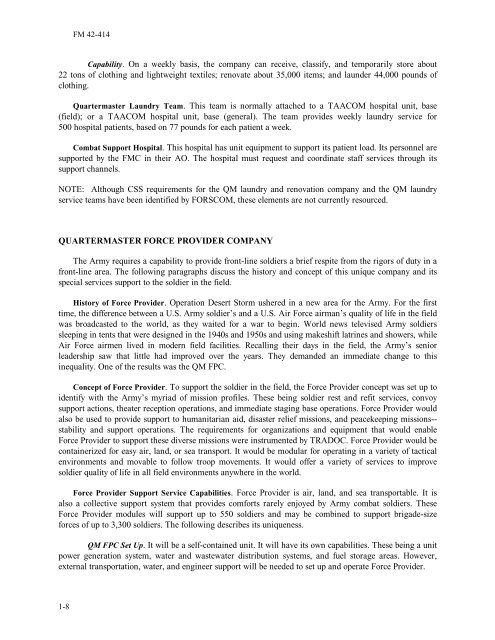Tactics, techniques, and procedures for - Army Electronic ...
Tactics, techniques, and procedures for - Army Electronic ...
Tactics, techniques, and procedures for - Army Electronic ...
You also want an ePaper? Increase the reach of your titles
YUMPU automatically turns print PDFs into web optimized ePapers that Google loves.
1-8<br />
FM 42-414<br />
Capability. On a weekly basis, the company can receive, classify, <strong>and</strong> temporarily store about<br />
22 tons of clothing <strong>and</strong> lightweight textiles; renovate about 35,000 items; <strong>and</strong> launder 44,000 pounds of<br />
clothing.<br />
Quartermaster Laundry Team. This team is normally attached to a TAACOM hospital unit, base<br />
(field); or a TAACOM hospital unit, base (general). The team provides weekly laundry service <strong>for</strong><br />
500 hospital patients, based on 77 pounds <strong>for</strong> each patient a week.<br />
Combat Support Hospital. This hospital has unit equipment to support its patient load. Its personnel are<br />
supported by the FMC in their AO. The hospital must request <strong>and</strong> coordinate staff services through its<br />
support channels.<br />
NOTE: Although CSS requirements <strong>for</strong> the QM laundry <strong>and</strong> renovation company <strong>and</strong> the QM laundry<br />
service teams have been identified by FORSCOM, these elements are not currently resourced.<br />
QUARTERMASTER FORCE PROVIDER COMPANY<br />
The <strong>Army</strong> requires a capability to provide front-line soldiers a brief respite from the rigors of duty in a<br />
front-line area. The following paragraphs discuss the history <strong>and</strong> concept of this unique company <strong>and</strong> its<br />
special services support to the soldier in the field.<br />
History of Force Provider. Operation Desert Storm ushered in a new area <strong>for</strong> the <strong>Army</strong>. For the first<br />
time, the difference between a U.S. <strong>Army</strong> soldier’s <strong>and</strong> a U.S. Air Force airman’s quality of life in the field<br />
was broadcasted to the world, as they waited <strong>for</strong> a war to begin. World news televised <strong>Army</strong> soldiers<br />
sleeping in tents that were designed in the 1940s <strong>and</strong> 1950s <strong>and</strong> using makeshift latrines <strong>and</strong> showers, while<br />
Air Force airmen lived in modern field facilities. Recalling their days in the field, the <strong>Army</strong>’s senior<br />
leadership saw that little had improved over the years. They dem<strong>and</strong>ed an immediate change to this<br />
inequality. One of the results was the QM FPC.<br />
Concept of Force Provider. To support the soldier in the field, the Force Provider concept was set up to<br />
identify with the <strong>Army</strong>’s myriad of mission profiles. These being soldier rest <strong>and</strong> refit services, convoy<br />
support actions, theater reception operations, <strong>and</strong> immediate staging base operations. Force Provider would<br />
also be used to provide support to humanitarian aid, disaster relief missions, <strong>and</strong> peacekeeping missions-stability<br />
<strong>and</strong> support operations. The requirements <strong>for</strong> organizations <strong>and</strong> equipment that would enable<br />
Force Provider to support these diverse missions were instrumented by TRADOC. Force Provider would be<br />
containerized <strong>for</strong> easy air, l<strong>and</strong>, or sea transport. It would be modular <strong>for</strong> operating in a variety of tactical<br />
environments <strong>and</strong> movable to follow troop movements. It would offer a variety of services to improve<br />
soldier quality of life in all field environments anywhere in the world.<br />
Force Provider Support Service Capabilities. Force Provider is air, l<strong>and</strong>, <strong>and</strong> sea transportable. It is<br />
also a collective support system that provides com<strong>for</strong>ts rarely enjoyed by <strong>Army</strong> combat soldiers. These<br />
Force Provider modules will support up to 550 soldiers <strong>and</strong> may be combined to support brigade-size<br />
<strong>for</strong>ces of up to 3,300 soldiers. The following describes its uniqueness.<br />
QM FPC Set Up. It will be a self-contained unit. It will have its own capabilities. These being a unit<br />
power generation system, water <strong>and</strong> wastewater distribution systems, <strong>and</strong> fuel storage areas. However,<br />
external transportation, water, <strong>and</strong> engineer support will be needed to set up <strong>and</strong> operate Force Provider.

















